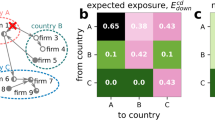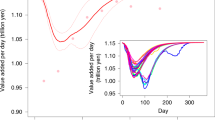Abstract
Poor economies not only produce less; they typically produce things that involve fewer inputs and fewer intermediate steps. Yet the supply chains of poor countries face more frequent disruptions—delivery failures, faulty parts, delays, power outages, theft and government failures—that systematically thwart the production process. To understand how these disruptions affect economic development, we modelled an evolving input–output network in which disruptions spread contagiously among optimizing agents. The key finding was that a poverty trap can emerge: agents adapt to frequent disruptions by producing simpler, less valuable goods, yet disruptions persist. Growing out of poverty requires that agents invest in buffers to disruptions. These buffers rise and then fall as the economy produces more complex goods, a prediction consistent with global patterns of input inventories. Large jumps in economic complexity can backfire. This result suggests why ‘big push’ policies can fail and it underscores the importance of reliability and gradual increases in technological complexity.
This is a preview of subscription content, access via your institution
Access options
Access Nature and 54 other Nature Portfolio journals
Get Nature+, our best-value online-access subscription
$29.99 / 30 days
cancel any time
Subscribe to this journal
Receive 12 digital issues and online access to articles
$119.00 per year
only $9.92 per issue
Buy this article
- Purchase on Springer Link
- Instant access to full article PDF
Prices may be subject to local taxes which are calculated during checkout






Similar content being viewed by others
References
Schumpeter, J. A. The Theory of Economic Development: An Inquiry Into Profits, Capital, Credit, Interest, and the Business Cycle (Transaction Books, New Brunswick, NJ, 1983).
Romer, P. M. Growth based on increasing returns due to specialization. Am. Econ. Rev. 77, 56–62 (1987).
Allcott, H., Collard-Wexler, A. & O’Connell, S. D. How do electricity shortages affect industry? Evidence from India. Am. Econ. Rev. 106, 587–624 (2016).
World Bank Group Enterprise Surveys Data (accessed 15 October 2015); http://www.enterprisesurveys.org/data/
Chaudhury, N., Hammer, J., Kremer, M., Muralidharan, K. & Rogers, F. H. Missing in action: teacher and health worker absence in developing countries. J. Econ. Perspect. 20, 91–116 (2006).
Caselli, F. in Handbook of Economic Growth vol. 1 (eds Aghion, P. & Durlauf, S. N.) 679–741 (Elsevier, 2005).
Hidalgo, C. A., Klinger, B., Barabási, A. L. & Hausmann, R. The product space conditions the development of nations. Science 317, 482–487 (2007).
Hidalgo, C. A. & Hausmann, R. The building blocks of economic complexity. Proc. Natl Acad. Sci. USA 106, 10570–10575 (2009).
Powell, B. The global supply chain: so very fragile. Fortune (12 December 2011)
Punter, A. Supply Chain Failures. A Study of the Nature, Causes and Complexity of Supply Chain Disruptions. (Airmic, London, 2013); https://www.riskmethods.net/resources/research/supply_chain_failures_2013_final_web.pdf
Ciccone, A. Input chains and industrialization. Rev. Econ. Stud. 69, 565–587 (2002).
Jones, C. I. Intermediate goods and weak links in the theory of economic development. Am. Econ. J. Macroecon. 3, 1–28 (2011).
Jones, C. I. Misallocation, Economic Growth, and Input–Output Economics in 10th World Congress of the Econometric Society (National Bureau of Economic Research, Cambridge, MA, 2011).
Acemoglu, D., Carvalho, V. M., Ozdaglar, A. & Tahbaz-Salehi, A. The network origins of aggregate fluctuations. Econometrica 80, 1977–2016 (2012).
Kremer, M. The O-ring theory of economic development. Q. J. Econ. 108, 551–575 (1993).
Battiston, S., Delli Gatti, D., Gallegati, M., Greenwald, B. & Stiglitz, J. E. Credit chains and bankruptcy propagation in production networks. J. Econ. Dyn. Control 31, 2061–2084 (2007).
Weisbuch, G. & Battiston, S. From production networks to geographical economics. J. Econ. Behav. Organ. 64, 448–469 (2007).
Mizgier, K. J., Wagner, S. M. & Holyst, J. A. Modeling defaults of companies in multi-stage supply chain networks. Int. J. Prod. Econ. 135, 14–23 (2012).
Henriet, F., Hallegatte, S. & Tabourier, L. Firm-network characteristics and economic robustness to natural disasters. J. Econ. Dyn. Control 36, 150–167 (2012).
Levine, D. K. Production chains. Rev. Econ. Dyn. 15, 271–282 (2012).
Contreras, M. G. A. & Fagiolo, G. Propagation of economic shocks in input-output networks: a cross-country analysis. Phys. Rev. E 90, 062812 (2014).
Hendricks, K. B. & Singhal, V. R. The effect of supply chain glitches on shareholder wealth. J. Oper. Manag. 21, 501–522 (2003).
Hendricks, K. B. & Singhal, V. R. An empirical analysis of the effect of supply chain disruptions on long-run stock price performance and equity risk of the firm. Prod. Oper. Manag. 14, 35–52 (2005).
Barrot, J.-N. & Sauvagnat, J. Input specificity and the propagation of idiosyncratic shocks in production networks. Quart. J. Econ. 131, 1543–1592 (2016).
Wang, Y. I., Li, J. & Anupindi, R. Risky suppliers or risky supply chains? An empirical analysis of sub-tier supply network structure on firm performance in the high-tech sector. Ross School of Business Paper No. 1297 Preprint at http://www.ssrn.com/abstract=2705654 (2015).
Aoki, M. & Yoshikawa, H. Reconstructing Macroeconomics: A Perspective from Statistical Physics and Combinatorial Stochastic Processes Ch. 4 (Cambridge Univ. Press, New York, NY, 2006).
Carvalho, V. M. From micro to macro via production networks. J. Econ. Perspect. 28, 23–48 (2014).
Duan, W.-Q. Modelling the evolution of national economies based on input–output networks. Comput. Econ. 39, 145–155 (2011).
Oberfield, E. Business networks, production chains, and productivity: a theory of input–output architecture. FRB of Chicago Working Paper No. 2011-12 Preprint at http://ssrn.com/abstract=1967148 (2012).
Carvalho, V. M. & Voigtländer, N. Input diffusion and the evolution of production networks. NBER Working Paper No. 20025 Preprint at http://www.nber.org/papers/w20025 (2014).
Tomlin, B. On the value of mitigation and contingency strategies for managing supply chain disruption risks. Manag. Sci. 52, 639–657 (2006).
Aydin, G., Babich, V., Beil, D. & Yang, Z. in The Handbook of Integrated Risk Management in Global Supply Chains 387–424 (John Wiley & Sons, Hoboken, NJ, 2011).
Bimpikis, K., Fearing, D. & Tahbaz Salehi, A. Multi-sourcing and miscoordination in supply chain networks. Stanford Business School Working Paper No. 3100 Preprint at https://www.gsb.stanford.edu/faculty-research/working-papers/multi-sourcing-miscoordination-supply-chain-networks (2014).
Ang, E., Iancu, D. A. & Swinney, R. Disruption risk and optimal sourcing in multi-tier supply networks. Manag. Sci. 63, 2397–2419 (2016).
Bakshi, N. & Mohan, S. Mitigating disruption cascades in supply networks. Preprint at http://faculty.london.edu/nbakshi/Nw.pdf (2015).
Murphy, K. M., Shleifer, A. & Vishny, R. W. Industrialization and the big push. J. Polit. Econ. 97, 1003 (1989).
Garb, Y. & Friedlander, L. From transfer to translation: using systemic understandings of technology to understand drip irrigation uptake. Agric. Sys. 128, 13–24 (2014).
Bold, T., Kaizzi, K., Svensson, J. & Yanagizawa-Drott, D. Low quality, low returns, low adoption: evidence from the market for fertilizer and hybrid seed in uganda. CEPR Discussion Papers 10743 Preprint at http://EconPapers.repec.org/RePEc:cpr:ceprdp:10743 (2015).
Sanjay, A. K. & Gupta, V. Gyandoot: trying to improve government services for rural citizens in India. Tech. Rep. 11, eGovernment for Development Preprint at http://www.egov4dev.org/transparency/case/gyandoot.shtml (2003).
Johnson, N. & Kotz, S. Urn Models and Their Application: An Approach to Modern Discrete Probability Theory (Wiley, 1977).
Woodbury, M. A. On a probability distribution. Ann. Math. Stat. 20, 311–313 (1949).
Toral, R. & Colet, P. in Stochastic Numerical Methods 235–260 (Wiley-VCH, Weinheim, Germany, 2014).
Helbing, D. Quantitative Sociodynamics: Stochastic Methods and Models of Social Interaction Processes 2nd edn (Springer-Verlag, Berlin, Germany, 2010).
Aoki, M. New Approaches to Macroeconomic Modeling: Evolutionary Stochastic Dynamics, Multiple Equilibria, and Externalities as Field Effects. (Cambridge Univ. Press, 1998).
Aoki, M. Modeling Aggregate Behavior and Fluctuations in Economics. (Cambridge Univ. Press, New York, NY, 2004).
Granovetter, M. Threshold models of collective behavior. Am. J. Sociol. 83, 1420–1443 (1978).
Watts, D. J. A simple model of global cascades on random networks. Proc. Natl Acad. Sci. USA 99, 5766–5771 (2002).
Jackson, M. O. & Yariv, L. Diffusion of behavior and equilibrium properties in network games. Am. Econ. Rev. 97, 92–98 (2007).
Ethier, W. J. National and international returns to scale in the modern theory of international trade. Am. Econ. Rev. 72, 389–405 (1982).
Romer, P. M. Endogenous technological change. J. Polit. Econ. 98, S71–S102 (1990).
Proviti. Managing Supply Chain Disruption Risk (2011); https://www.protiviti.com/US-en/insights/managing-supply-chain-disruption-risk
Simchi-Levi, D., Schmidt, W. & Wei, Y. From Superstorms to Factory Fires: Managing Unpredictable Supply-Chain Disruptions (Harvard Business Review, 2014); https://hbr.org/2014/01/from-superstorms-to-factory-fires-managing-unpredictable-supply-chain-disruptions
Tang, C. S. Robust strategies for mitigating supply chain disruptions. Int. J. Logist. Res. Appl. 9, 33–45 (2006).
Bak, P., Chen, K., Scheinkman, J. & Woodford, M. Aggregate fluctuations from independent sectoral shocks: self-organized criticality in a model of production and inventory dynamics. Res. Econom. 47, 3–30 (1993).
Gabaix, X. The granular origins of aggregate fluctuations. Econometrica 79, 733–772 (2011).
Burlon, L. How do aggregate fluctuations depend on the network structure of the economy? SSRN Electronic Journal Preprint at http://www.ssrn.com/abstract=2028093 (2012).
Baqaee, D. R. Cascading failures in production networks. SSRN Electronic Journal Preprint at https://papers.ssrn.com/sol3/papers.cfm?abstract_id=2909868 (2015).
Francois, P. & Zabojnik, J. Trust, social captial, and economic development. J. Eur. Econ. Assoc. 3, 51–94 (2005).
Humphreys, B. R., Maccini, L. J. & Schuh, S. Input and output inventories.J. Monetary Econ. 47, 347–375 (2001).
Iacoviello, M., Schiantarelli, F. & Schuh, S. Input and output inventories in general equilibrium. Int. Econ. Rev. 52, 1179–1213 (2011).
Khan, A. & Thomas, J. K. Inventories and the business cycle: an equilibrium analysis of (S, s) policies. Am. Econ. Rev. 97, 1165–1188 (2007).
Wen, Y. Input and output inventory dynamics. Am. Econ. J. Macroeconom. 3, 181–212 (2011).
Atlas of Economic Complexity. Economic Complexity Index (accessed 8 November 2015); http://atlas.cid.harvard.edu/rankings/country/download/
Hausmann, R., Hidalgo, C. A., Bustos, S., Coscia, M. & Simoes, A. The Atlas of Economic Complexity: Mapping Paths to Prosperity (MIT Press, Cambridge, MA, 2014).
McArthur, J. et al. Ending Africa’s poverty trap. Brookings Pap. Econ. Act. 1, 117–240 (2004).
Azariadis, C. & Stachurski, J. in Handbook of Economic Growth (eds Aghion, P. & Durlauf, S.) 295–384 (Elsevier, 2005).
Barrett, C. B., Garg, T. & McBride, L. Well-being dynamics and poverty traps. Annu. Rev. Res. Econ. 8, 303–327 (2016).
Easterly, W. Reliving the 1950s: the big push, poverty traps, and takeoffs in economic development. J. Econ. Growth 11, 289–318 (2006).
Gershenson, C. & Helbing, D. When slower is faster. Complexity 21, 9–15 (2015).
North, D. C. Institutions, Institutional Change and Economic Performance. (Cambridge Univ. Press, Cambridge, UK, 1990).
Acemoglu, D., Johnson, S. & Robinson, J. A. in Handbook of Economic Growth (eds Aghion, P. & Durlauf, S. N.) 386–414 (Elsevier, 2005).
Morduch, J. Poverty and vulnerability. Am. Econ. Rev. 84, 221–225 (1994).
Haushofer, J. & Fehr, E. On the psychology of poverty. Science 344, 862–867 (2014).
The World Bank. GDP Per Capita (in Current US$) (accessed 15 February 2016); http://data.worldbank.org/indicator/NY.GDP.PCAP.CD
Hilft, B. E. in Worldriskreport 2014. 64–66 (United Nations University Institute for Environment and Human Security, accessed 11 February 2016); http://i.unu.edu/media/ehs.unu.edu/news/4070/11895.pdf.
World Health Organization. Adult Mortality Data by Country (accessed 15 February 2016); http://apps.who.int/gho/data/node.main.11?lang=en
Acknowledgements
C.D.B. and M.H.B. acknowledge funding from the James S. McDonnell Foundation for the Postdoctoral Award and the Scholar Award (respectively) in Complex Systems. P.P. and F.V.-R. acknowledge funding from the Italian Ministry of Education Progetti di Rilevante Interesse Nazionale grant 2015592CTH. No funders had any role in study design, data collection and analysis, decision to publish or preparation of the manuscript.
Author information
Authors and Affiliations
Contributions
All authors designed and performed the research and wrote the paper. C.D.B. and K.H. analysed the data.
Corresponding author
Ethics declarations
Competing interests
The authors declare no competing interests.
Additional information
Publisher’s note: Springer Nature remains neutral with regard to jurisdictional claims in published maps and institutional affiliations.
Electronic supplementary material
Supplementary Information
Supplementary Notes 1–6 Supplementary Figure 1, Supplementary References 1–15.
Life Sciences Reporting Summary
Life Sciences Reporting Summary
Rights and permissions
About this article
Cite this article
Brummitt, C.D., Huremović, K., Pin, P. et al. Contagious disruptions and complexity traps in economic development. Nat Hum Behav 1, 665–672 (2017). https://doi.org/10.1038/s41562-017-0190-6
Received:
Accepted:
Published:
Issue Date:
DOI: https://doi.org/10.1038/s41562-017-0190-6
This article is cited by
-
How Connected is Too Connected? Impact of Network Topology on Systemic Risk and Collapse of Complex Economic Systems
Computational Economics (2021)



